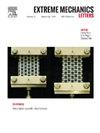一种表征叠加方位剪切作用下软物质空化压力的方法
IF 4.5
3区 工程技术
Q2 MATERIALS SCIENCE, MULTIDISCIPLINARY
引用次数: 0
摘要
在许多应用中(例如,接触运动、交通事故、钝器外伤、创伤性脑损伤、药物输送、手术),生物组织和其他软物质受到复杂的多轴应力状态,可引起各种材料变形和破坏模式。空化是一种特殊的软物质失效模式,人们对它的理解和表征都不够充分。据作者所知,空化只在最初的无应力样品中进行了研究。软物质在多轴应力状态下的行为数据的缺乏阻碍了广义空化理论的发展和验证。本研究介绍了一种叠加剪切空化(SSC)装置,可以检测扭转剪切应力在软物质中空化成核、膨胀和坍缩中的作用。我们提出的SSC测试扩展了完善的针诱导空化(NIC)实验,将凝胶置于Taylor-Couette细胞中而不是传统的烧杯中。这种修改可以在注射器针头插入和加压之前对凝胶样品施加方位剪切应力。为了证明它的能力,我们用SSC仪器测量了预加载不同程度扭转的三嵌段共聚物(PMMA-PnBA-PMMA)凝胶样品的临界压力(Pc)。在一组有限的实验中,发现Pc通常随着施加的预剪切应力的增加而增加,这与Lopez-Pamies及其同事首先提出的广义空化理论在定性上一致,从而提供了一定程度的证据,表明SSC装置按预期运行。嵌入凝胶顶部表面的运动跟踪器粒子提供了额外的证据,证明SSC装置产生了预期的方位预变形场。本文章由计算机程序翻译,如有差异,请以英文原文为准。
A method to characterize the cavitation pressure of soft matter under superimposed azimuthal shear
In many applications (e.g. contact sports, vehicular accidents, blunt force trauma, traumatic brain injury, drug delivery, surgeries), biological tissues and other soft matter are subject to complex, multi-axial stress states that can induce a variety of material deformation and failure modes. Cavitation is a particular soft matter failure mode that is insufficiently understood and poorly characterized. To the best of the authors’ knowledge, cavitation has only been investigated in initially stress-free samples. The lack of data for soft matter behavior under multi-axial stress states prevents the development and validation of generalized cavitation theories. This study introduces a superimposed shear cavitation (SSC) apparatus that enables an examination of the role torsional shear stress plays in cavity nucleation, expansion, and collapse in soft matter. Our proposed SSC test expands on the well-established needle-induced cavitation (NIC) experiment by housing the gel in a Taylor–Couette cell instead of a conventional beaker. This modification enables the application of azimuthal shear stresses to the gel sample prior to the insertion and pressurization of the syringe needle. To demonstrate its capability, our SSC apparatus was used to measure the critical pressure () of tri-block copolymer (PMMA-PnBA-PMMA) gel samples pre-loaded with various degrees of torsion. In a limited set of experiments, was found to generally increase with increasing amount of applied pre-shear stress, in qualitative agreement with a generalized cavitation theory first introduced by Lopez-Pamies and co-workers, thereby providing some degree of evidence that the SSC apparatus is functioning as intended. Motion tracker particles embedded in the top surface of the gel provide additional evidence that the SSC apparatus generates the intended azimuthal pre-deformation field.
求助全文
通过发布文献求助,成功后即可免费获取论文全文。
去求助
来源期刊

Extreme Mechanics Letters
Engineering-Mechanics of Materials
CiteScore
9.20
自引率
4.30%
发文量
179
审稿时长
45 days
期刊介绍:
Extreme Mechanics Letters (EML) enables rapid communication of research that highlights the role of mechanics in multi-disciplinary areas across materials science, physics, chemistry, biology, medicine and engineering. Emphasis is on the impact, depth and originality of new concepts, methods and observations at the forefront of applied sciences.
 求助内容:
求助内容: 应助结果提醒方式:
应助结果提醒方式:


